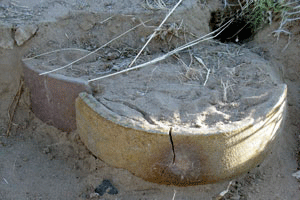

Despite the restrictive environment of the internment camps built across the western United States, interned Japanese Americans and Japanese residents struggled to maintain their cultural identity. At the Amache camp in Colorado, archaeologists have uncovered water pipes reused as planters for a traditional Japanese garden.
(Courtesy Bonnie Clark)
During no other war in history have so many people been forcibly removed from their homes and confined in internment, concentration, and death camps. Archaeology, with its unique ability to discover details of daily life often left out of personal journals and official histories, is now being used to document the lives of WWII's interned, among them more than 100,000 Japanese Americans and Japanese, and millions of Jews, Gypsies, Communists, criminals, homosexuals, and political prisoners. Whereas on the battlefield the goal is not necessarily life, but victory, the most meaningful fight in a camp is for survival. Archaeologists are uncovering evidence that people not only survived, but also struggled to maintain their identity and dignity even in the most restrictive and dehumanizing environments.
After the bombing of Pearl Harbor in 1941 led to the U.S. declaration of war on Japan, the U.S. government believed that the Japanese military intended to attack the West Coast. Approximately 70,000 Japanese-American citizens and 50,000 Japanese residents of the U.S. were perceived as a threat to national security and interned. According to Bonnie Clark of the University of Denver, who works at Camp Amache in Colorado, even in these camps, internees had an overwhelming need to make their environment familiar and habitable. At Amache, Clark is finding that the internees, more than half of whom were gardeners or farmers from California, created gardens—entryway gardens of a type deeply rooted in Japanese culture, communal gardens, and vegetable gardens where they grew daikon, melons, and Japanese cucumbers and eggplant. Clark has also discovered evidence that the internees were remarkably resourceful. In one garden she found water pipes reused as planters, and in another, a piece of copper wire, a rare wartime material, used to train a Chinese elm, possibly as a bonsai. The internees were even modifying the soil with eggshell to make the high desert more fertile. "One of the few things (they) had control of was this part of the landscape," says Clark.
In northern Idaho, Stacey Camp of the University of Idaho has begun a long-term project to investigate Kooskia, one of the less familiar and more remote internment camps. Here too, Camp is uncovering evidence of the internees' efforts to maintain a connection with their Japanese identity. "We have found gaming pieces used in the Japanese game of Go and a medicine bottle manufactured in Japan which must have been carried into the camp in the one suitcase the owner was allowed. This is particularly interesting because Japanese imports were banned during the war," Camp says. She has also found archaeological evidence of a response to the internees' petitions for better medical care, including a set of dentures, false teeth, and denture molds.
Whereas the history of the Japanese internment camps is perhaps lesser known, Europe's concentration and death camps are one of the most carefully examined features of WWII. Alongside oral history and the Nazi's impeccable record-keeping, archaeology is revealing an even more complete picture of this side of the war. Scholars and survivors alike have asked whether it is proper to excavate where millions died from exhaustion, starvation, disease, and deliberate attempts at extermination. However, for the death camps in Poland, such as Belzec, which the Nazis attempted to destroy in 1943 as the Red Army approached, and Sobibor, of which very little remains standing, archaeology may provide virtually the only chance to understand how the camps' layout and architecture are evidence of the atrocities committed there. The pathway to Sobibor's gas chambers was only uncovered during excavations in 2007.
According to Claudia Theune of the University of Vienna, who has worked at Sachsenhausen and Mauthausen, concentration camps in Germany and Austria respectively, there is also another reason to excavate the camps. "Material culture tells us a great deal about the suffering of the victims and their strategies for survival, and also something about the perpetrators. Archaeological finds are a new source with something to add to the discussion of terror and survival," she says. For example, at Sachsenhausen, Theune found high-quality dishes and silver and stainless steel cutlery, mostly forks and knives. These she identified as belonging to the guards. "But we also have many more spoons, which are easier to make than knives or forks, and most are made of less valuable aluminum or sheet metal. These clearly belonged to prisoners. When there is not enough cutlery, people do what they can to eat," she says. Theune has also found combs, some of which were handmade from salvaged plastic. "There was certainly a need for hygiene and cleanliness to maintain one's dignity. These are things you will not find in the written sources," she adds. Lastly, Theune believes that as Germany (of the past) is to blame for the crimes of the Nazi era, the modern nation is obliged to preserve that history, long after the last survivors and eyewitnesses are gone. "These finds have their own biography," she says. "They carry meaning from the time they were used, and for us today, they are also objects of memory."
Advertisement

Advertisement







